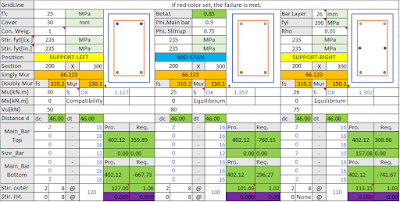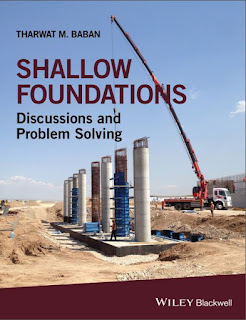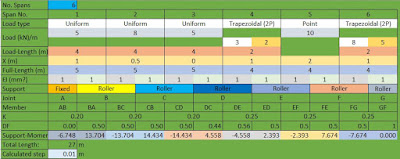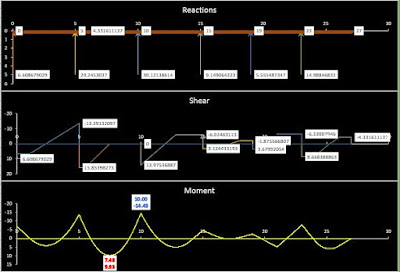Sunday, May 3, 2020
Saturday, November 23, 2019
Two Way Slab Design by the Coefficient Method
The coefficient method makes use of tables of moment coefficients for a variety of conditions. These coefficients are based on elastic analysis but also account for inelastic redistribution. In consequence, the design moment in either direction is smaller by an appropriate amount than the elastic maximum moment in that direction. The moments in the middle strips in the two directions are computed from
The method provides that each panel be divided in both directions into a middle strip whose width is one-half that of the panel and two edge or column strips of one-quarter of the panel width (see figure below). The moments in both directions are larger in the center portion of the slab than in regions close to the edges. Correspondingly, it is provided that the entire middle strip be designed for the full, tabulated design moment. In the edge strips this moment is assumed to decrease from its full value at the edge of the middle strip to one-third of this value at the edge of the panel. This distribution is shown for the moments Ma in the short span direction in figure below. The lateral variation of the long span moments Mb is similar.
Saturday, September 21, 2019
Shallow Foundations Discussions and Problem Solving-Tharwat M. Baban
This book is intended primarily to introduce civil engineers, especially geotechnical engineers and all civil engineering students reading the specialist subjects of soil mechanics and geotechnical engineering, to the fundamental concepts and application of shallow foundation analysis and design. Also, the furnished material can be considered as an essential reference work for practicing civil engineers, consulting engineers and government authorities.
The primary focus of this book is on interfacing structural elements with the underlying soil, which is, in the author’s opinion, where the major focus of shallow foundation engineering lies.
Tuesday, June 4, 2019
Advanced Reinforced Concrete Design - N Krishna Raju
The book presents the design of a variety of reinforced concrete structures like Continuous beams, Portal frames, Silos, Bunkers, Chimneys, Shells, Folded plates, Hyperbolic cooling towers, Trusses, Deep beams, Box culverts, Bridge deck systems.
The design of these advanced reinforced concrete structures conform to the revised Indian standard Code IS: 45-1978 and SI units have been adopted for all the design examples.
Wednesday, February 27, 2019
Design of Isolated Footings of Rectangular form using a New Model
In the design of reinforced concrete rectangular footings subject to axial load and flexure in two directions, there are different pressures in the four corners, these are exercised by soil. In this paper, a mathematical model is developed to take into account the real pressure of soil acting on the contact surface of the footings, these pressures are presented in terms of the mechanical elements (axial load, around moment the axis “X” and around moment the axis “Y”), when applying the load that must support said structural member.
The classical model takes into account only the maximum pressure of the soil for design of footings and it is considered uniform at all points of contact area of footing, i.e., that all the contact surface has the same pressure. Also a comparison is developed between the two models as shown in the results table. The data show that the classical model is larger than the model proposed. Therefore, normal practice to use the classic model will not be a recommended solution. Then the proposed model is the most appropriate, since it is more economic and also is adjusted to real conditions.
Tuesday, February 26, 2019
Visual Basic for Applications in Microsoft Excel
Visual Basic for Applications in Microsoft Excel – Advanced is designed to equip participants with a more profound knowledge of VBA. Users will be able to simplify complex processes involving pivot tables, charts and working with external data sources. The Pre-requisite for this course is trainee has to be familiar with the programming environment. Essentials fundamental knowledge of Macros and VBA is needed. You need to know how to apply the use of Excel Objects, Variables, Looping, Functions and sub-routines.
Saturday, February 16, 2019
Moment Distribution Method - Reaction_Shear_Moment Diagram Spreadsheet
Moment Distribution Method - Reaction_Shear_Moment Diagram Spreadsheet
The moment distribution method is a structural analysis method for statically indeterminate beams and frames developed by Hardy Cross.
The moment distribution method is a structural analysis method for statically indeterminate beams and frames developed by Hardy Cross.
In the moment distribution method, every joint of the structure to be analyzed is fixed so as to develop the fixed-end moments. Then each fixed joint is sequentially released and the fixed-end moments (which by the time of release are not in equilibrium) are distributed to adjacent members until equilibrium is achieved. The moment distribution method in mathematical terms can be demonstrated as the process of solving a set of simultaneous equations by means of iteration.









